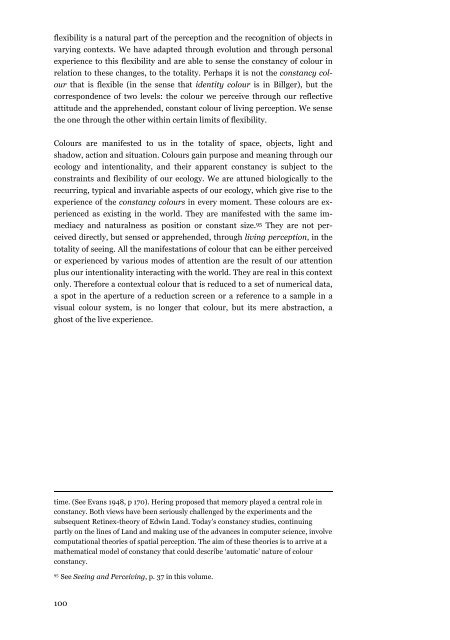Lightness and Brightness and Other Confusions
Lightness and Brightness and Other Confusions
Lightness and Brightness and Other Confusions
You also want an ePaper? Increase the reach of your titles
YUMPU automatically turns print PDFs into web optimized ePapers that Google loves.
flexibility is a natural part of the perception <strong>and</strong> the recognition of objects in<br />
varying contexts. We have adapted through evolution <strong>and</strong> through personal<br />
experience to this flexibility <strong>and</strong> are able to sense the constancy of colour in<br />
relation to these changes, to the totality. Perhaps it is not the constancy colour<br />
that is flexible (in the sense that identity colour is in Billger), but the<br />
correspondence of two levels: the colour we perceive through our reflective<br />
attitude <strong>and</strong> the apprehended, constant colour of living perception. We sense<br />
the one through the other within certain limits of flexibility.<br />
Colours are manifested to us in the totality of space, objects, light <strong>and</strong><br />
shadow, action <strong>and</strong> situation. Colours gain purpose <strong>and</strong> meaning through our<br />
ecology <strong>and</strong> intentionality, <strong>and</strong> their apparent constancy is subject to the<br />
constraints <strong>and</strong> flexibility of our ecology. We are attuned biologically to the<br />
recurring, typical <strong>and</strong> invariable aspects of our ecology, which give rise to the<br />
experience of the constancy colours in every moment. These colours are experienced<br />
as existing in the world. They are manifested with the same immediacy<br />
<strong>and</strong> naturalness as position or constant size. 95 They are not perceived<br />
directly, but sensed or apprehended, through living perception, in the<br />
totality of seeing. All the manifestations of colour that can be either perceived<br />
or experienced by various modes of attention are the result of our attention<br />
plus our intentionality interacting with the world. They are real in this context<br />
only. Therefore a contextual colour that is reduced to a set of numerical data,<br />
a spot in the aperture of a reduction screen or a reference to a sample in a<br />
visual colour system, is no longer that colour, but its mere abstraction, a<br />
ghost of the live experience.<br />
time. (See Evans 1948, p 170). Hering proposed that memory played a central role in<br />
constancy. Both views have been seriously challenged by the experiments <strong>and</strong> the<br />
subsequent Retinex-theory of Edwin L<strong>and</strong>. Today’s constancy studies, continuing<br />
partly on the lines of L<strong>and</strong> <strong>and</strong> making use of the advances in computer science, involve<br />
computational theories of spatial perception. The aim of these theories is to arrive at a<br />
mathematical model of constancy that could describe ‘automatic’ nature of colour<br />
constancy.<br />
<br />
See Seeing <strong>and</strong> Perceiving, p. 37 in this volume.<br />
100
















